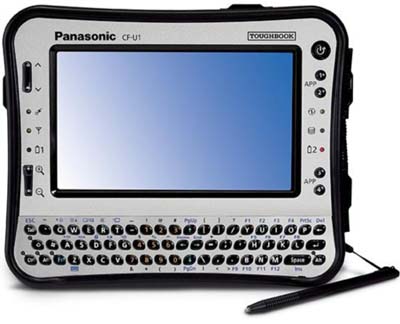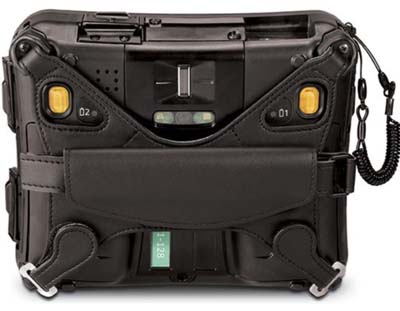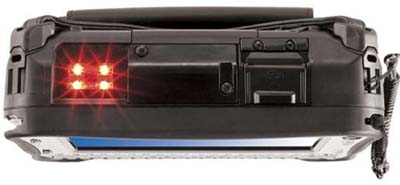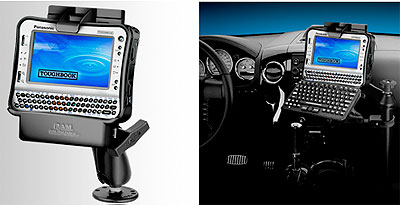With the hardened Toughbook 01 Pocket PC gone, Panasonic introduced the rugged CF-U1 "ultra lightweight PC" in June of 2008. It's a rugged UMPC, really, and exactly the type of device we suggested would make sense when Microsoft first introduced the UMPC platform a couple of years ago.

According to Panasonic, the Toughbook CF-U1 was designed for deployment in environments as diverse as construction, mining operations, oil and gas refineries, manufacturing, railroad yards, city streets and storage warehouses, and to be used by insurance adjusters, building inspectors, police officers, firefighters and other first responders. The magnesium-bodied 7.2 x 5.9 inch device is just over two inches thick, weighs a bit over two pounds, and it powered by Intel's new and super-efficient Atom Z520 processor that runs at speeds up to 1.33GHz with a 533MHZ Frontside Bus but has a stunningly low TDP (thermal design power) of just two watts. A fanless design, the Toughbook U1 promises to deliver both decent performance as well as exemplary battery life (Panasonic claims nine hours from its twin batteres with a total capacity of 42 watt-hours).

The Toughbook U1 uses the standard UMPC form factor of a small tablet that you're expected to hold with both hands while typing on the wide-format 61-key keyboard designed for thumb-typing. The layout of the keys is such that half of the QWERTY setup is on the left and the other half on the right, with a numeric keypad and punctuation keys inbetween them, requiring some getting used to. Zoom in and out buttons as well as a scroll rocker make navigation easier, and there are four programmable hardware function keys on top of numerous keyboard functions.
The U1 runs Windows Vista Business (there is a Windows XP downgrade option) on a wide-format 1024 x 600 pixel touch screen display that measures 5.6 inches diagonally and has anti-reflective coating for sunlight-readability. There is no rotating media; instead, the U1 uses either a 16GB or 32GB solid state disk.

For a device this small, the Toughbook U1 offers plenty of connectivity and expansion. Onboard you find a USB 2.0 port, audio in/out and an expansion connector. Expansion modules play an important role with the U1 as they provide either serial/Ethernet/SmartCard interfaces or a manetic stripe reader. The device itself has a SD Card slot and comes with 802.11a/b/g/draft-n WiFi via an Intel WiFi Link 5100 module. There is also Bluetooth v2.0 with Enhanced Data Rate and you can get optional integrated 3G WWAN modules supporting either EV-DO or HSDPA. Also optionally available are an integrated GPS received, a 2 megapixel camera, or your choice of 1D or 2D barcode readers or an RFID reader.
This being a Toughbook, the CF-U1 is built to last and take some punishment. It has a magnesium case, a sealed all-weather design with an IP54 rating, and it can survive 4-foot drops. It is also rain-, spill-, dust- and vibration- resistant in compliance with MIL-STD-810F testing procedures.
Since the tough, compact Panasonic U1 will be used in many different settings, and have many different mounting requirements, RAM Mounts has designed a whole system of mounting products for the U1 (see below).

See a detailed description of the RAM Mounts for the Toughbook U1 or check the RAM Mounts for the Panasonic Toughbook CF-U1 page.
We reserve judgement on the overall functionality of the Toughbook U1 concept until we've had hands-on on a review sample. As is, the U1 seems an interesting alternative to rugged mini notebooks such as the GD-Itronix MR-1.



